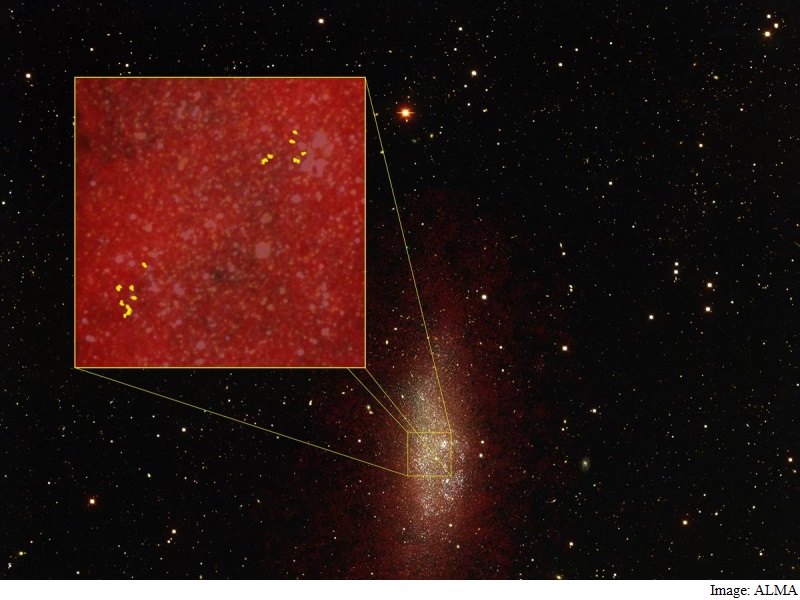- Home
- Science
- Science News
- Astronomers Discover How a Dwarf Galaxy Becomes a Star Forming Powerhouse
Astronomers Discover How a Dwarf Galaxy Becomes a Star-Forming Powerhouse

These clouds, which are nestled within a heavy blanket of interstellar material, help explain how dense star clusters are able to form in the tenuous environments of a galaxy thousands of times smaller and far more diffuse than our own Milky Way.
The galaxy is named Wolf-Lundmark-Melotte, more commonly known as WLM, which is located approximately three million light years away from Earth.
"For many reasons, dwarf irregular galaxies like WLM are poorly equipped to form star clusters," said Monica Rubio, astronomer with the University of Chile and lead author.
These galaxies are fluffy with very low densities. They also lack the heavy elements that contribute to star formation.
"Such galaxies should only form dispersed stars rather than concentrated clusters, but that is clearly not the case," Rubio noted.
By studying this galaxy with the Atacama Large Millimeter/submillimeter Array (ALMA) telescope in northren Chile, the astronomers were able to locate for the first time compact regions that appear able to emulate the nurturing environments found in larger galaxies.
These regions were discovered by pinpointing the almost imperceptible and highly localised millimeter wavelength light emitted by carbon monoxide (CO) molecules, which are typically associated with star-forming interstellar clouds.
Molecules, and carbon monoxide in particular, play an important role in star formation
Further studies with ALMA will also help determine the conditions that formed the globular clusters found in the halo of the Milky Way.
Astronomers believe these much larger clusters may have originally formed in dwarf galaxies and later migrated to the halo after their host dwarf galaxies dispersed.
The paper appeared in the scientific journal Nature.
Catch the latest from the Consumer Electronics Show on Gadgets 360, at our CES 2026 hub.
Related Stories
- Samsung Galaxy Unpacked 2025
- ChatGPT
- Redmi Note 14 Pro+
- iPhone 16
- Apple Vision Pro
- Oneplus 12
- OnePlus Nord CE 3 Lite 5G
- iPhone 13
- Xiaomi 14 Pro
- Oppo Find N3
- Tecno Spark Go (2023)
- Realme V30
- Best Phones Under 25000
- Samsung Galaxy S24 Series
- Cryptocurrency
- iQoo 12
- Samsung Galaxy S24 Ultra
- Giottus
- Samsung Galaxy Z Flip 5
- Apple 'Scary Fast'
- Housefull 5
- GoPro Hero 12 Black Review
- Invincible Season 2
- JioGlass
- HD Ready TV
- Laptop Under 50000
- Smartwatch Under 10000
- Latest Mobile Phones
- Compare Phones
- OPPO Reno 15 Pro Max
- Honor Win RT
- Honor Win
- Xiaomi 17 Ultra Leica Edition
- Xiaomi 17 Ultra
- Huawei Nova 15
- Huawei Nova 15 Pro
- Huawei Nova 15 Ultra
- Asus ProArt P16
- MacBook Pro 14-inch (M5, 2025)
- OPPO Pad Air 5
- Huawei MatePad 11.5 (2026)
- Xiaomi Watch 5
- Huawei Watch 10th Anniversary Edition
- Acerpure Nitro Z Series 100-inch QLED TV
- Samsung 43 Inch LED Ultra HD (4K) Smart TV (UA43UE81AFULXL)
- Asus ROG Ally
- Nintendo Switch Lite
- Haier 1.6 Ton 5 Star Inverter Split AC (HSU19G-MZAID5BN-INV)
- Haier 1.6 Ton 5 Star Inverter Split AC (HSU19G-MZAIM5BN-INV)

















